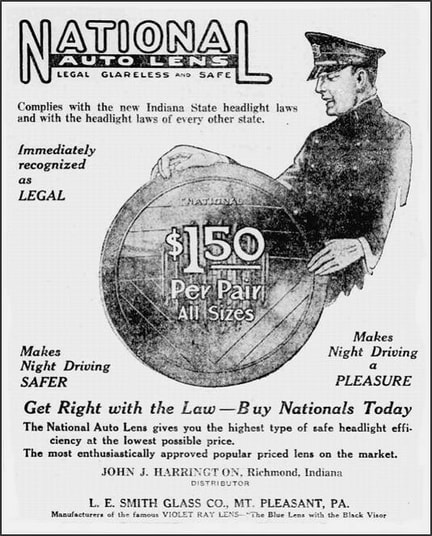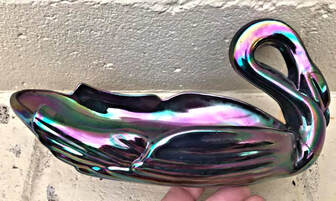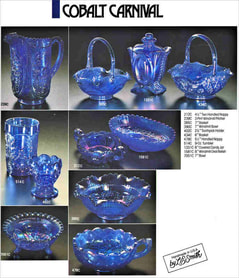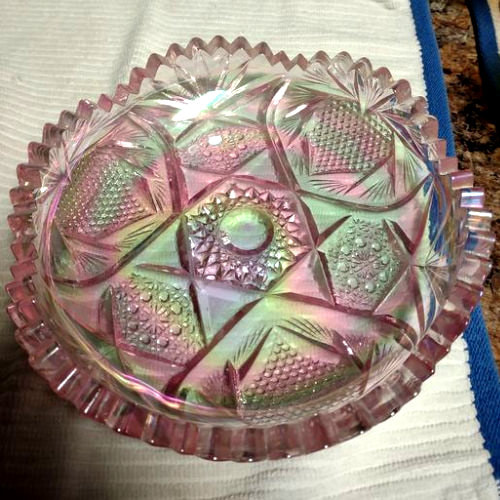L. E. Smith Glass Co. - Revival / Contemporary Carnival Glass
|
A Brief History of L. E. Smith *
The Early Years In 1907, Louis ("Lew") E. Smith and his associates founded the L.E. Smith Glass Co., at Jeannette, PA, where they leased the decorating plant of the McKee-Jeannette Glass Co. The Society for Historical Archaeology report that “Smith had been the manager of the McKee-Jeannette decorating establishment since 1906 and essentially continued in that position with the new corporation”. In 1909, the L.E. Smith Glass Co., of Jeannette, PA, purchased the Mt. Pleasant, PA plant of the Anchor Glass Co. (in a bankruptcy sale), which then re-opened under Smith in January 1910. In the early years production focused on making various lines of practical glassware for home and kitchen use - such as salt and pepper shakers, sherbet glasses, tumblers, beer glasses and mustard pots (even packing the pots with its own "German-style" mustard!). One of its early customers was the famous F. W. Woolworth retail chain. Smith branched out into many innovative areas of glassmaking, often with a practical, utilitarian slant. It is credited with making the first headlight lens for the Ford Motor's Model T automobiles, and subsequently developing non-glare headlights. Other innovations included the original glass coffee percolator domes, juice reamers and the vault lights seen on sidewalks. Milk Glass represented one of their early - and very successful - products, which was a top seller over a long period of time. Above: milk glass items in an extract from a Smith catalogue from around 1930. These moulds were re-used for Contemporary Carnival production - see the Swan and Dancing Ladies pictures in the Gallery.
|
A Smith ad in the Richmond Palladium, Indiana, December 1921
|
* When we were researching for our second Schiffer book - A Century of Carnival Glass - we were in contact with many of the glassmaking companies around the world that were still in business at that time. L. E. Smith Glass Co. very kindly sent us some wonderful and fascinating material that included the L. E. Smith Story - as told in their own words. We have reproduced it in full here: The L. E. Smith Story.
|
Contemporary Carnival Glass Production
In the 1950s-1960s, the business developed into decorative glassware. In the 1960s they experimented with iridescent ware and in January 1971 they went into production with Contemporary Carnival Glass with their first two items in Contemporary Carnival - John F Kennedy and Abraham Lincoln collector's plates. Each one was made in amethyst, and was originally limited to 2500 pieces, numbered on the base. Also in 1971, the company was purchased by Owens-Illinois, with Smith operating as a wholly owned subsidiary. Glass labelled "Fayette" was also made by L.E. Smith. Our understanding is that the name was used c. 1960s to sell via discount outlets such as K-Mart. This enabled Smith to do that without compromising their established trade (as per research by Tom Felt). In 1985, Dorothy Taylor’s Carnival Glass Encore reported that Hank Opperman, president of L E Smith (and a one-time Imperial employee), stated that the company had “probably 100 to 200 moulds from Imperial.” Smith had also bought many moulds from McKee in the 1950s and, having used them over a long period of time, some were revived for Contemporary Carnival production. Examples of the reproductions from old Imperial moulds include the Windmill pitcher and tumblers, the 7” Windmill bowl (see right) and the 8” inch oval pickle dish, the Pansy pickle dish and the Open Rose / Lustre Rose bowl; most of these that have since been made by Smith are in red and cobalt Carnival. Interestingly, this means that Smith have produced re-issues of re-issues! (Imperial re-issued them in the 1960s and 1970s before they closed, and the moulds were later bought and re-used by Smith). |
A Windmill bowl in red - a reproduction made by Smith from the Imperial mould. Marked with Smith's " S ". Seeck Auctions.
|
Carnival Patterns and Colours
Carnival colours used by Smith have been amethyst / purple, red / amberina, pale pink, iridized crystal (called crystal lustre), green, amber and ice blue.
Carnival Patterns and Colours
Carnival colours used by Smith have been amethyst / purple, red / amberina, pale pink, iridized crystal (called crystal lustre), green, amber and ice blue.
Noticeably, red was a favourite Smith colour, but an information note issued in November 1988 by Rossos, the wholesale glass dealers, reported that Smith had been ordered by the Environmental Protection Agency to cease production of red glass until their furnaces had been renovated. The reason cited was that chemicals were being released into the air which were not permitted.
|
The delightful miniature vase on the right is about 5 inches high, and the flower holder is centrally placed between the front and back of the horse. It has the whimsical name Carol's Sure Win! Cherished Glass Wares (CGW - Mary Walrath / Walrath’s Limited Editions) saw the design in an old Smith catalogue, and Smith was able to locate the original mould. CGW obtained the rights to the mould and had it trademarked on the base with CGW in a heart shape. Smith then made it for CGW as an "exclusive" - initially in amber and in amberina in 1979, selling at $12.50 and $15 respectively. |
Later the Carol's Sure Win vase was made in blue ("Mediterranean Blue") and crystal lustre. Each colour was to be limited to 2000, but only only 840 were made in amber, 501 in amberina and 665 in blue. Smith also made other "exclusive" Carnival Glass items for Cherished Glass Wares, for example, an amberina Ohio Star vase, of which only 600 were actually released, and an amberina Daisy and Button vase, #4666 (limited to 314).
Later the Carol's Sure Win vase was made in blue ("Mediterranean Blue") and crystal lustre. Each colour was to be limited to 2000, but only only 840 were made in amber, 501 in amberina and 665 in blue. Smith also made other "exclusive" Carnival Glass items for Cherished Glass Wares, for example, an amberina Ohio Star vase, of which only 600 were actually released, and an amberina Daisy and Button vase, #4666 (limited to 314).
|
Two magnificent amethyst punch sets were manufactured by Smith in 1972: Inverted Feather and Hobstar (aka Hobstar and Feather) with eight matching cups, and the Grape and Vine (aka Heavy Grape) with twelve cups - see Gallery below. A white Hobstar punch set was made for Levay in 1976.
Hobstar water sets in green, amber and white Carnival as well as red Moon and Stars items and several covered hen and turkey novelties are also typical Smith products (see Gallery below). On the right is an unusual Smith item which is not often seen or recognised - it is their #65 Swan - shown here in purple, courtesy of Sandy McClintock. It is about 8 inches long, and it has a unusual base (see top row, far right). It was also made in non-iridised colours such as the "Almond Nouveau Slag" colour, shown bottom row, far right, courtesy of Gail Ann Bradley. |
|
Commemoratives and other limited "collector" editions were also produced by Smith. In 1977, they made the HOACGA red / amberina Good Luck hatpin holder shown here on the far right. In 1980, five hundred Wine and Roses miniature water sets in ice blue opalescent were produced for Dorothy Taylor’s Encore. The pitcher is marked on the base: "ENCORE CARNIVAL GLASS, K. C. MO., 1980. The moulds for the miniature set (goblets and pitcher) were made in Cambridge, Ohio by Al Botson of Botson Machine Company. |
|
Smith's Marks
All items at Smith were handmade, with most glass (but not all) being marked with their trademark letter S which also appears with tiny letters G and C within the curves of the S (right, courtesy of Dave Doty). On the far right is Smith's " S " mark - this one is on the base of the Morgan Dollar plate, with the Limited Edition information for the plate, number 2723, 7-71 (July 1971). |
Smith's first two collector's plates, John F Kennedy and Abraham Lincoln, were released in 1971 in Limited Editions of 2500 each. They were popular and much in demand, and in 1971-72, Smith issued more Limited Edition plates, as below. The catalogue states that 5000 of each were to be made, but only 2000 of Lee and Davis and the full 5000 of the Morgan Dollar plates were made, after which the moulds were broken. The same open edge was used by Smith on an amethyst ICGA souvenir plate in 1973, that featured the club’s motif, the town pump (see picture in the Smith Gallery).
Closure
In July 2004, a bank filed a federal suit against Smith Glass, claiming the manufacturer had defaulted on loans totalling $5.01 million, and in November 2004, court papers confirmed that judgement had been entered against Smith Glass. Glassmaking ceased on June 30, after 11th-hour talks to find a buyer collapsed, but a few weeks later, some glassworkers were rehired to try to keep the business going.
At the time, Smith’s customers were said to include Williams-Sonoma, and Martha Stewart Living. Smith’s products were seen in catalogues for Bloomingdale's, Spiegel, Restoration Hardware and Neiman-Marcus.
In January 2005, William A. Kelman, a Pittsburg businessman, bought the assets of Smith Glass including equipment, inventory, machinery and receivables. He formed a new company, Port Augustus Glass Co. LLC, which was named after a town in his native Scotland. The intention was to preserve nearly a century of glassmaking history at one of the last handmade glass factories in the USA, but ultimately it was not to be, and the business finally closed. (Source: C.M. Mortimer writing in the TRIBUNE-REVIEW, January 18, 2005).
In July 2004, a bank filed a federal suit against Smith Glass, claiming the manufacturer had defaulted on loans totalling $5.01 million, and in November 2004, court papers confirmed that judgement had been entered against Smith Glass. Glassmaking ceased on June 30, after 11th-hour talks to find a buyer collapsed, but a few weeks later, some glassworkers were rehired to try to keep the business going.
At the time, Smith’s customers were said to include Williams-Sonoma, and Martha Stewart Living. Smith’s products were seen in catalogues for Bloomingdale's, Spiegel, Restoration Hardware and Neiman-Marcus.
In January 2005, William A. Kelman, a Pittsburg businessman, bought the assets of Smith Glass including equipment, inventory, machinery and receivables. He formed a new company, Port Augustus Glass Co. LLC, which was named after a town in his native Scotland. The intention was to preserve nearly a century of glassmaking history at one of the last handmade glass factories in the USA, but ultimately it was not to be, and the business finally closed. (Source: C.M. Mortimer writing in the TRIBUNE-REVIEW, January 18, 2005).
Smith's Contemporary Carnival catalogues.
Shown below are four catalogue pages of Smith's showing some of Smith's very extensive range of Contemporary Carnival Glass. They are small size "thumbnail" images - if you click on each one of them they link to full size, high resolution images.
Shown below are four catalogue pages of Smith's showing some of Smith's very extensive range of Contemporary Carnival Glass. They are small size "thumbnail" images - if you click on each one of them they link to full size, high resolution images.
|
Amethyst Carnival
Click for Full Size Image |
Gold / Amber and Crystal Carnival
Click for Full Size Image Bicentennial Carnival Collection 1975-6
Click for Full Size Image |
Green Carnival and collector's plates
Click for Full Size Image |
L. E. Smith Picture Gallery - click on any thumbnail to open a larger image.
* L E Smith #388 pattern. Part of Smith's Heritage Line in the 1980s. It was made in crystal, as well as red and blue Carnival. It is an old United States Glass pattern - their No. 15124 - that collectors know by the Heacock name of "Omnibus" (OMN Keystone).
** The Whirling Star punch set was also called Galaxy by L. E. Smith. It was originally a McKee pattern called Wiltec.

























































